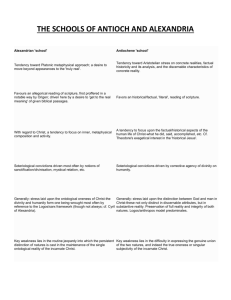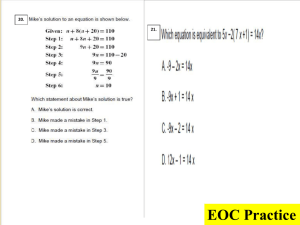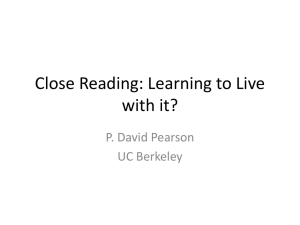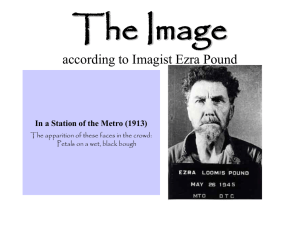Eschatology Class Notes Lecture 1
advertisement
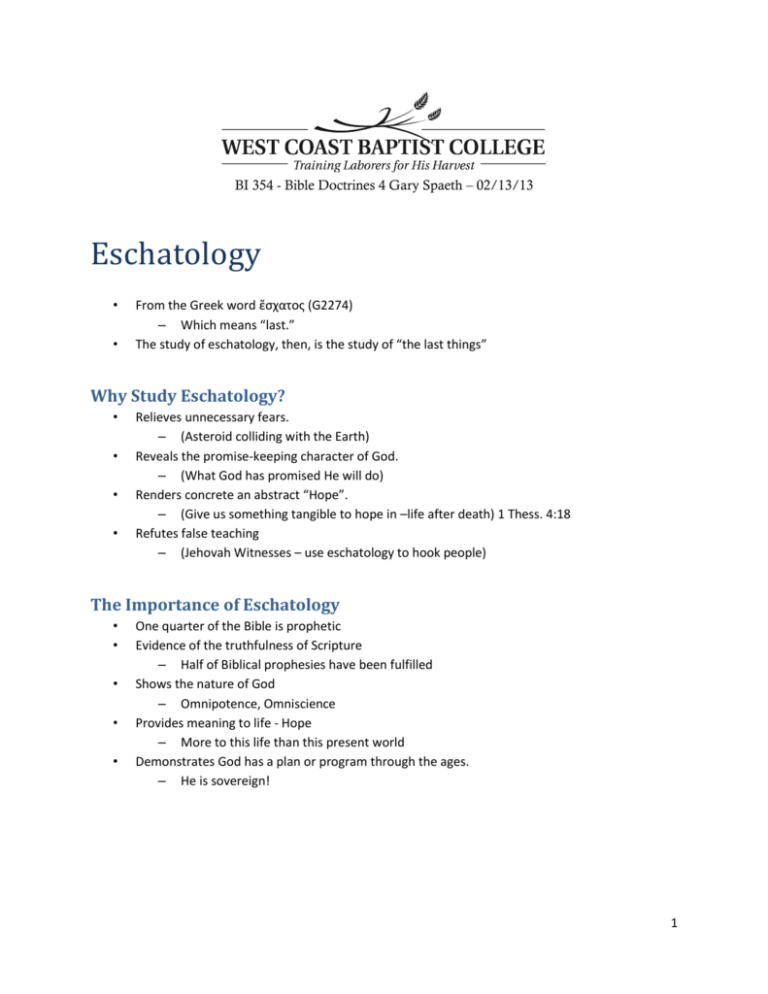
BI 354 - Bible Doctrines 4 Gary Spaeth – 02/13/13 Eschatology • • From the Greek word ἔσχατος (G2274) – Which means “last.” The study of eschatology, then, is the study of “the last things” Why Study Eschatology? • • • • Relieves unnecessary fears. – (Asteroid colliding with the Earth) Reveals the promise-keeping character of God. – (What God has promised He will do) Renders concrete an abstract “Hope”. – (Give us something tangible to hope in –life after death) 1 Thess. 4:18 Refutes false teaching – (Jehovah Witnesses – use eschatology to hook people) The Importance of Eschatology • • • • • One quarter of the Bible is prophetic Evidence of the truthfulness of Scripture – Half of Biblical prophesies have been fulfilled Shows the nature of God – Omnipotence, Omniscience Provides meaning to life - Hope – More to this life than this present world Demonstrates God has a plan or program through the ages. – He is sovereign! 1 Five Crucial Questions regarding Eschatology Is the return of Christ literal? Is the return of Christ future? Is the return of Christ premillennial? Is the tribulation period future? Is the rapture before the tribulation? • Lecture #1 Understanding the correct method of interpretation • The Historical Development of Interpretation Key Terms • • • Interpretation: – The process by which the Scriptures are understood by the reader. Hermeneutics: – The theory, method, or rules of biblical interpretation. Exegesis: – The process of discovering the original meaning of the biblical text, “bringing it out” (“exegeting”) by studying the text according to the authorial intent in its historical and grammatical contexts. The Jewish Position on Interpretation • Jewish interpretation began with Ezra in the post-exilic era. – Nehemiah 8:7-8 (Ezra) “caused the people to understand the law” • Two different schools of interpretation developed: – Peshat • very rigid in interpretation, literal – Sod • more flexible, mystical or secret sense, allegorical. 2 The Alexandrian Judaism • • • This view endeavored to reconcile the Old Testament with Greek philosophy. Their approach was allegorical. The literal was viewed as immature understanding of Scripture The Karaitic Interpretation view • This view regarded the Scripture as the sole authority in matters of faith, and were literal in outlook. The Cabbalistic Interpretation view • This as an extreme view of literalism, sometimes referred to as “Letterism” – even the letters, accents and vowels point of the Hebrew Masoretic text were regarded as inspired with supernatural power. – However, they were allegorical in their interpretation. The Palestinian View • Developed Sound principles of exegesis which reflected a literal approach to interpretation of Scriptures – Words must be understood in terms of its sentence and context. – Scriptures dealing with similar topics should be compared. – A clear passage is given preference over an obscure one. The Hellenistic Interpretation view • Had a tendency to move toward the allegorical method trying to fit Old Testament truth with Greek philosophy and mythology. The Christian views of Interpretation • Patristic Interpretation (100-600 A.D.) – Alexandrian position • Allegorical • The primary meaning of Scripture was found in a secondary, hidden sense beneath the words of Scripture. – Antiochean Position • Literal - grammatico-historical method. • They sought to find the meaning of Scripture in its original sense. – Western Position • Combined elements of both allegorical and the literal methods, but its concentration really was on the allegorical method. Espousal of the Authority of the institutional Church and tradition in the interpretation of Scriptures 3 The Medieval Interpretation (600-1500 A.D.) • • • Continuation of the western view More in line with the traditional interpretation of the Roman Catholic Church. This was combined with a now deeply entrenched allegorical view which a notable fourfold sense of Scripture was practiced. Jerusalem was viewed in this system • Literal – it refers to the city of Jerusalem • Allegorical – it refers to the Church • Morally – it refers to the human soul • Analogical – it refers to the Heavenly city The Reformation Interpretation (1500-1600 A.D.) • The Reformers returned to the literal method of interpretation. (Luther, Zwingly, Calvin, Melanchthon) – They declared that the Scriptures were the only infallible basis for interpretation. The Scriptures determined what the church ought to teach; the church does not determine what the Scriptures teach. – They departed from the fourfold sense and adopted the single, original sense of Scripture based on the Grammatico-historical exegesis. – They emphasized the Holy Spirit’s work to authenticate and to illuminate the Scriptures so one could understand their meaning. Interpretation of Scriptures Two Essential Methods • • Allegorical method – Spiritualization – Beneath the letter or obvious is the real meaning of the passage (Ramm) – Literal - historical grammatical method – Accept as basic the literal rendering of the sentence unless by virtue of the nature of the sentence or phrase or clause within the sentence this is not possible. (Ramm) The Allegorical Method of interpretation – Ramm – The method of interpreting the literary text that regards the literal sense as a vehicle for the secondary, more spiritual and more profound sense of more spiritual and profound meaning; so that the literal and historical context has no real bearing or significance on the text. – One story on top of another (Pilgrims Progress) 4 The Allegorical Method Examples of allegory in Scripture • Allegory - characters or events represent or symbolize ideas and concepts. – Psalm 23 “The LORD is my shepherd” – Isaiah 5:1-6 “My wellbeloved hath a vineyard” Allegorical method of interpretation • • The Church is Israel Hebrews 8:8 For finding fault with them, He says, "Behold, days are coming, says the Lord, When I will effect a new covenant With the house of Israel and with the house of Judah; Dangers of the Allegorical Method • • • 1. It does not interpret scripture – It has no regard for word definitions and is given to speculation. – unsound, inconsistent and subjective interpretation 2. The Authority in interpretation ceases to be the Scripture, but the mind of the interpreter – Allows the interpreter complete freedom to twist the meaning of passages 3. One is left without any means by which the conclusions of the interpretation may be tested. – This reduces the Scriptures to what seems reasonable to the interpreter. The Allegorical Method defended • • 1. It is a method is used in Bible – Gal 4:22-31 “Which things are an allegory” – Allegorical interpretation was not used in the Bible – Paul was not using an allegorical method of interpreting the OT, but was explaining an allegory. – Scripture abound in allegories 2. It is seen in the New Testament Use of Types – NT makes typical applications of the OT • Matt. 12:39-40 [prophet Jonah], • John 3:14 [As Moses lifted up the serpent] – Not using an allegorical method. – With types one must understand the literal interpretation of the text in order to convey the truth in the type. 5 Literal - historical grammatical method • A method that gives each word the same exact basic meaning it would have in normal, ordinary customary usage, whether employed in writing, speaking, or thinking. Defending the Literal Method 1. This is the normal approach in all languages 2. All secondary meanings of documents, parables, types, allegories, and symbols, depend on the literal interpretation of the terms. 3. The greater part of the Bible makes adequate sense when interpreted literally. 4. The Literal approach does not rule our figures of speech, symbols, allegories, and types, but if the nature of the sentence so demands it, it readily yields to the second sense. 5. This method is the only one constant with the nature of inspiration. Advantages of the Literal Method 1. 2. 3. 4. 5. Grounds interpretation in facts It exercises control over the interpretation It has great success in opening up the word of God. It give a standard upon which all interpretation can be tested. It spares us from the weakness of human reason and mystical type view of interpretation. The Literal Method and Symbolism and Figurative language • • The Bible contains symbols and figurative language. This does not mean that the figurative language has to be interpreted by a literal method. The figurative language and symbols help to enhance the literal meaning. – It helps us understand the unknown by the known. – When God is trying to reveal to us truth that is unfamiliar He uses examples which parallel it with what we understand in the truth which is already familiar. 6
